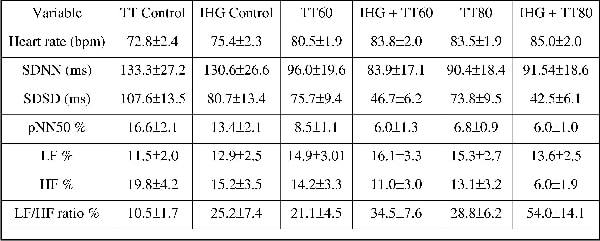Heart rate variability (HRV) measures variations between consecutive heart beats (RR intervals) and is assessed by time and frequency domain indices (1). Time indices include the standard deviation (SD) of RR (SDNN), SD of differences between consecutive RR (SDSD) and the percentage of consecutive RR intervals > 50 ms (pNN50). Frequency indices include high frequency (HF) and low frequency (LF) representing parasympathetic (PNS) and sympathetic (SNS) activity, respectively. Postural stress (lying to sitting) increases HRV (2). However, little is known about HRV during a combination of two autonomic stressors. The aim is to see how combined stressors (tilting at 60 and 80 deg and isometric handgrip) affect HRV. Twenty-four healthy subjects, 21 Asians and 3 Afro-Caribbean (15 men, 9 women) with mean weight, height and age ± SD; 64.83 ± 10.9kg, 166.10 ± 7.8cm, 25.08 ± 4.4years respectively, volunteered for this study. Subject’s maximum voluntary contraction (MVC) were assessed on a hand grip transducer (MIE Medical Research Ltd). Subjects lay in the supine position for 5 min, during which HRV was measured using a chest belt and watch (Polar S810i), followed by isometric handgrip exercise for 1 min whilst maintaining 30% of their MVC and recording HRV. This procedure was repeated after tilting to 60 and 80 deg using a motorized tilt table. HRV was analysed using Polar and Prism 4.0 software. Repeated measures ANOVA with Bonferroni post-test was used to analyse differences in HRV indices. From control to the combined stressors there is an increase in HR (decreased RR interval), LF and LF/HF ratio, whilst SDNN, SDSD, pNN50 and HF decreased (Table 1). Differences between control and stressors were significant (P<0.05) for all variables except LF which was only significant at 60 deg head up tilting and handgrip. Our results show increased HRV with a higher dominance of SNS over PNS during combined stressors compared to single stressors or control, but the larger decrease in HF during combined stressors suggest a larger decrease of the PNS effect.
University College London 2006 (2006) Proc Physiol Soc 3, PC81
Poster Communications: Heart rate variability during combined head-up tilting and isometric handgrip exercise in humans
Mohammed Shahabu Meah1, Masimiliano Casu1, Luther Jegannathan Sabanathan1
1. School of Health & Bioscience, University of East London, London, United Kingdom.
View other abstracts by:
Table 1
Where applicable, experiments conform with Society ethical requirements.

